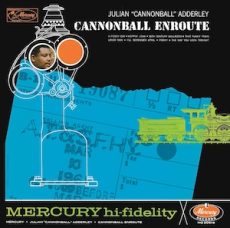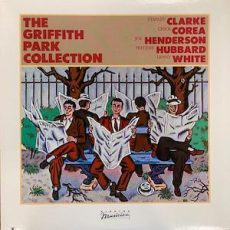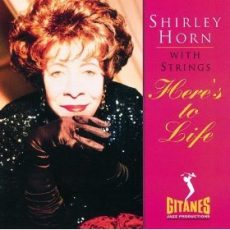
Requisites
Cannonball Enroute ~ Julian “Cannonball” Adderley | By Eddie Carter
The weather outside was frightful because it was raining hard here in Atlanta. After the sun returned, it became a perfect time to hear the smooth alto sax of Julian “Cannonball” Adderley. He enters this morning’s spotlight with a 1961 album, Cannonball Enroute (Mercury Records MG 20616), backed by his quintet of Nat Adderley on cornet, Junior Mance on piano, Sam Jones on bass, and Jimmy Cobb on drums. My copy is the original U.S. Mono release. A Foggy Day by George and Ira Gershwin opens the album. The quintet starts at a medium beat, setting the stage for Cannonball’s lead solo. Nat picks up the pace in a muted reading until his brother returns to lead the ensemble out.
Hoppin’ John by Nat Adderley takes off with Junior’s speedy introduction ahead of the ensemble’s quick melody. Cannonball ignites the opening solo with a furious charge. Nat responds with plenty to say next. Junior follows with a rapid reading, and Jimmy shares the finale with the front line before the quintet makes a quick exit. 18th Century Ballroom by Nat Adderley and Ray Bryant begins with the ensemble’s pretty melody. Nat opens with a solo that’s quite compelling. Cannonball follows with a superb, articulate statement, then Junior gets the last word in an excellent reading leading back to the closing chorus and finale.
The group takes a trip aboard That Funky Train by Nat Adderley next. Sam and Jimmy get the train rolling with their introduction to the group’s theme. Sam has the first solo and walks with conviction. Junior is next with a very down-home presentation. Nat brings up the rear with a muted finale ahead of the reprise, and the rhythm section slowly dissolves into nothingness. Lover Man (Oh, Where Can You Be) by Jimmy Davis, Roger Ramirez and Jimmy Sherman starts Side Two with a solo showcase for Cannonball. The ensemble begins the introduction before the altoist steps in to deliver a tender melody and the song’s only statement until the group wraps it up.
I’ll Remember April by Don Raye, Gene De Paul, and Pat Johnson begins briskly with Jimmy’s introduction ahead of the quintet’s theme. Cannonball gets things going with a swift opening statement. Nat follows with a heated reading; then Junior takes over for a sparkling solo preceding the group’s return for the close. Porky by Cannonball and Nat Adderley is a fun tune that begins with the front line’s collective melody in a medium setting. Nat swings comfortably into the first interpretation; then Sam takes a relaxing turn in the following reading. Cannonball completes the solos with an attractive piece before the closing chorus ends with a Dixieland flavor.
The Way You Look Tonight by Dorothy Kern and Jerome Kern starts with Junior’s introduction to the quintet’s speedy melody. Cannonball surges into the lead solo like a whirlwind, and then Nat makes a blistering statement. Junior steps up next with an accelerated performance, and Jimmy engages in a brief exchange with both horns into the theme’s restatement and climax. It’s unknown who produced the session or who the recording engineer was, but the album’s sound quality is excellent with a clear soundstage.
Cannonball Enroute was Adderley’s fifth Mercury release and his third with this group. The quintet worked well as a cohesive unit but lasted only two years. He would return in 1959 with a new quintet after a brief time with Miles Davis that would become his most successful. If you’re a new or seasoned fan of Julian “Cannonball” Adderley and are in the mood for a wonderful hard bop album, I offer for your consideration, Cannonball Enroute on your next record shopping trip. It’s a great, if overlooked, album in his large discography that’s worth every penny for a spot in your library!
~ Cannonball’s Sharpshooters (Mercury Records MG 20531/SR 60208), Sophisticated Swing (EmArcy MG 36110) – Source: Discogs.com
~ A Foggy Day, I’ll Remember April, Lover Man (Oh, Where Can You Be), The Way You Look Tonight – Source: JazzStandards.com
© 2024 by Edward Thomas CarterMore Posts: choice,classic,collectible,collector,history,instrumental,jazz,music,saxophone

Jazz Poems
VICTROLADead forty years Bird brings his lips to the reed.
He rules the roost, and rues the rest,
Do wot-jadda bop.
Recovered from the shock
The war veteran Hitler found the doctor
Who cured his hysterical deafness,
And had the man killed , hoping that I
Might never exist to tell the story here,
A little distorted.
But Illinois Jacquet playing ‘Round Midnight
On the bassoon, better even
Than the death speech of Falstaff.
And listen, Moshe Leib Halpern, I
Have a miracle cabinet
Made in Japan–listen.
ROBERT PINSKY | 1940
from Jazz Poems ~ Selected and Edited by Kevin Young
More Posts: book,classic,collectible,history,jazz,library,poet

Requisites
The Griffith Park Collection ~ Stanley Clarke, Chick Corea, Joe Henderson, Freddie Hubbard, Lenny White | By Eddie Carter
This morning’s record from the library unveils a unique jazz collaboration. The Griffith Park Collection (Elektra Musician E1-60025) is the second of two studio albums recorded over four days with an all-star ensemble: Freddie Hubbard on flugelhorn (tracks: A3, B3) and trumpet (A1, A2, B1), Joe Henderson on tenor sax (A1 to A3, B1, B3), Chick Corea on piano, Stanley Clarke on upright bass, and Lenny White on drums. Their first record was Echoes of An Era, an album of jazz standards with Chaka Khan. This was a rare reunion for Corea, Clarke, and White, who had not played together since they were members of Return to Forever. My copy is the 1982 U.S. Stereo release.
The opener is L’s Bop by Lenny White. The quintet’s lively theme takes off at a brisk pace, leading to Joe’s swinging opening solo. Freddie maintains the vigorous intensity in the second reading; then Chick skillfully navigates the third statement into a short exchange with Lenny until the theme’s reprise and fade out. The pace slows down slightly for Why Wait by Stanley Clarke, a medium-tempo blues that opens with the ensemble’s theme. Joe gets this grooving affair going in the first solo. Freddie answers him with an exceptional performance; then Chick provides the exclamation point preceding the group’s return for the closing chorus and exit.
October Ballade by Chick Corea begins with the pianist’s soothing introduction ahead of Freddie’s tender melody. Joe has the first solo and builds each chorus gently with deep emotion until Chick takes over for a brief, lovely interpretation. The quintet wraps up things with a poignantly touching reprise and finale. Side Two gets underway with Happy Times by Freddie Hubbard, a cheerful tune that the group takes to heart in the theme. Joe greets the opening statement joyfully, and then Freddie comes in for a bright and bubbly solo. Chick adds to the festive atmosphere in the second interpretation. Lenny delivers a finale that is quite enjoyable before the close.
Remember, by Steve Swallow is a beautiful waltz that opens with the trio’s thoughtfully polite introduction and theme. Chick carefully cultivates the lead solo with delicate notes. Stanley’s reply is an affectionately warm interpretation as Lenny’s drums softly compliment him until the ensemble’s theme restatement. Guernica by Lenny White is a musical portrait of Pablo Picasso’s Spanish Civil War painting. It is a haunting song and the album’s most adventurous tune with a melancholy theme. Joe begins the opening solo with an airy, nostalgic tone. Freddie emerges next with a breathtaking reading; then Chick delivers an enthusiastic statement preceding the group’s return for the climax.
Lenny White produced The Griffith Park Collection and Bernie Kirsh was the recording engineer. The album’s sound quality is good, with a softer soundstage in the highs, midrange, and bass. At just under forty minutes, it is a hidden gem that flows with a beat and does not disappoint. If you are in the mood for an excellent album with remarkable chemistry and exceptional performances. In that case, I invite you to check out The Griffith Park Collection by Stanley Clarke, Chick Corea, Joe Henderson, Freddie Hubbard, and Lenny White on your next record shopping trip. It is a wonderful album that I highly recommend for your library, and I am sure it will reward your purchase for years to come!
~ Echoes of An Era (Elektra E1-60021) – Source: Discogs.com © 2024 by Edward Thomas CarterMore Posts: bass,choice,classic,collectible,collector,drums,history,instrumental,jazz,music,piano,saxophone,trumpet

Jazz Poems
FOUR BONGOS: TAKE A TRAIN for Vinnie The drummer wears suspenders to look like an old-timer, and plays a salsa “Caravan,” bad boy from the panyard with an evil, evil beat. The conga man chants Yoruba and shakes his sweat loose on a girl up front. His hand worries the drum like a live fish thrashing. Call the bassist “Pops,” with his grizzly goatee, his Banshee yelp, his rhumba step. Tha hall is fluorescent. “Take a Train,” Lawrence Welk called that tune, and played. Ellington, hovers above this group like changeable weather, in gabardine. ELIZABETH ALEXANDER | 1962from Jazz Poems ~ Selected and Edited by Kevin Young
More Posts: book,classic,collectible,history,jazz,library,poet

Requisites
The very first time I heard Shirley Horn sings and play piano was in the 1970s at the Bohemian Caverns in Washington, D.C. and I fell in love with her voice and style. By then she had recorded five albums and when I was on the radio she became a part of my regular playlist. Here’s To Life is a studio album recorded in September 1991 by the vocalist, and released in 1992. The album was arranged by Johnny Mandel who composed three of the songs on the album. He also received a Grammy Award for Best Instrumental Arrangement Accompanying Vocals on this album. It’s a quiet album of ballads that once again showcases Shirley’s talent. Johnny Mandel arranged and conducted the recording session for the Verve label.
The album opens with the title track with Here’s To Life which became her signature song. The music was written by Artie Butler and the poignant lyrics were written by Phyllis Molinary. The lyric, known world-wide as one of her finest works and the song is considered a modern day jazz standard. She followed with a medley of Come A Little Closer/Wild Is the Wind. The former song is about New Yorkers, the city and the cell phone that disputes a couple’s marriage. The song is paired with Wild Is The Wind which was written as the theme song for the 1959 film of the same name and recorded by Johnny Mathis. It was nominated for an Oscar for Best Song.
How Am I to Know? by Jack King and Dorothy Parker takes the third slot on the album. A Time for Love was written for the 1966 film An American Dream. The Begman/ Mandel tune, Where Do You Start tells the story of a couple breaking up and undecided about what belongs to whom. The next song You’re Nearer is a Lorenz Hart/Richard Rodgers composition for the Broadway musical Too Many Girls. Our next entry in Return to Paradise was written for the 1953 film of the same name by Dimitri Tiomkin and Ned Washington. Isn’t It A Pity was composed by the Gershwins for the unsuccessful 1933 musical Pardon My English, however, the song became a part of the Great American Songbook.
Quietly There is taken from the noir film Harper that starred Paul Newman as a detective. If You Love Me is an English adaptation of the popular French song “Hymne à l’amour of Hymn To Love. The album closes with Summer is the first English version of the Italian standard Estate. She ordered English lyrics after hearing Joao Gilberto’s version, which spread the song to worldwide fame.
Shirley Horn sings and plays piano and is joined by bassist Charles Ables and dummer Steve Williams as her core trio. She invited trumpeter Wynton Marsalis – to play on A Time For Love and Quietly There. Richard Todd plays the French horn on the title track. Reminding me of how precious life is and how much we should live and love, this has become my favorite album by this vocalist. I hope you enjoy it just as much as I.
More Posts: choice,classic,collectible,collector,history,instrumental,jazz,music,vocal



